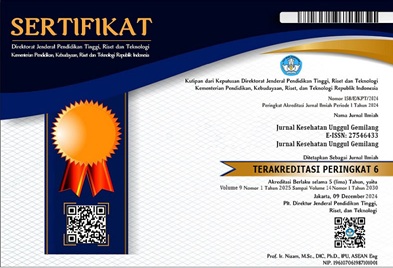PENGARUH MINUMAN JAHE DAN KUNYIT ASAM TERHADAP PENURUNAN DISMENORE PADA REMAJA PUTRI KELAS X SMKN 6 PANDEGLANG TAHUN 2024
Kata Kunci:
Dismenore, Jahe, Kunyit Asam, RemajaAbstrak
Pendahuluan: Menstruasi adalah bagian normal dari proses siklus alami yang terjadi pada wanita sehat diantara masa pubertas hingga akhir tahun-tahun reproduksi. Menurut Kemenkes, standard WHO terkait angka kejadian dismenorea di Indonesia adalah 64,25%, terdiri dari 54,89% dismenorea primer dan 9,36% dismenorea sekunder. Selama 50 tahun terakhir, 75% wanita pernah mengalami kram menstruasi. Salah satu cara nonfarmakologi yang dapat dilakukan adalah dengan ramuan jahe dan kunyit asam. Tujuan: Penelitian ini bertujuan mengetahui pengaruh ramuan jahe dan kunyit asam terhadap penurunan dismoenore pada remaja putri kelas X SMKN 6 Pandeglang tahun 2024. Metode: Desain penelitian ini adalah Quasi experimental dengan Two Group Pretest-post test design. Kelompok I dengan intervensi jahe sedangkan kelompok II dengan intervensi kunyit asam. Penelitian ini dilakukan di SMKN 6 Pandeglang dengan jumlah sampel yaitu 56 remaja putri yang terdiri dari 26 kelompok I dengan intervensi jahe dan kelompok II sebanyak 26 orang dengan intervensi kunyit asam. Hasil: berdadsarkan uji Paired t test didapatkan hasil nilai p-value minuman jahe 0,000 (<0,05) dan nilai p-value kunyit asam 0,000 (<0,05) berarti ada perbedaaan pengaruh minuman jahe dan kunyit asam pada penurunan nyeri dismenore pada remaja putri. Kesimpulan: minuman jahe lebih efektif penurunan nyeri dismenore pada remaja putri kelas X di SMKN 6 Pandeglang
Introduction: Menstruation is a normal part of the natural cycle process that occurs in healthy women between puberty and the end of the reproductive years. According to the Ministry of Health, the WHO standard for the incidence of dysmenorrhea in Indonesia is 64.25%, consisting of 54.89% primary dysmenorrhea and 9.36% secondary dysmenorrhea. Over the past 50 years, 75% of women have experienced menstrual cramps. One non-pharmacological method that can be done is with a concoction of ginger and turmeric tamarind. Purpose: This study aims to determine the effect of ginger and turmeric tamarind concoctions on reducing dysmenorrhea in female adolescents of class X SMKN 6 Pandeglang in 2024. Method: The design of this study was Quasi experimental with Two Group Pretest-posttest design. Group I with ginger intervention while group II with turmeric tamarind intervention. This study was conducted at SMKN 6 Pandeglang with a sample size of 56 female adolescents consisting of 26 group I with ginger intervention and group II as many as 26 people with turmeric tamarind intervention. Results: Based on the Paired t-test, the results of the p-value of ginger drink were 0.000 (<0.05) and the p-value of turmeric and tamarind was 0.000 (<0.05), meaning that there was a difference in the effect of ginger and turmeric and tamarind drinks on reducing dysmenorrhea pain in female adolescents. Conclusion: Ginger drink is more effective in reducing dysmenorrhea pain in class X teenage girls at SMKN 6 Pandeglang






